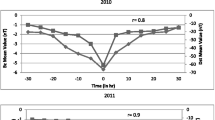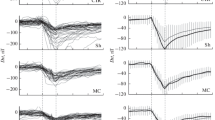Abstract
This paper presents a statistical analysis of global ionospheric variation during quiet and disturbed geomagnetic conditions from December 2008 to June 2019. The study comprehends ascending and descending solar periods of the 24th solar cycle. The vertical Total Electron Content (vTEC) data of CODE-GIM are utilized to reveal the TEC variation in the regional and global regions. The disturbance storm time index (Dst) with a storm criterion of diurnal Dstmin less than –20 nT was used to identify the magnetically quiet/disturbed conditions, and the geomagnetic storms were identified by diurnal Dstmin less than –50 nT. 36 and 43% of the ascending/descending periods were magnetically disturbed days, respectively. There was no significant change in vTEC variation in the high and middle latitude regions. Still, in the low latitudes, vTECs increased 50 and 25% in the disturbed days of ascending/descending periods, respectively. vTEC values in the low latitudes were found to be 33% higher than the middle latitudes and 100% higher than the high latitudes in quiet days for both periods. vTEC values in the low latitudes were also found to be 50 and 200% higher than the middle and high latitudes in disturbed days, respectively. Also, the Dst and global Total Electron Content (gTEC) variations were compared using the superposed epoch analysis (SEA) for geomagnetic storms. The gTEC values indicate the average vTEC of CODE-GIM grids. The SEA results indicate that the gTEC variation is similar to the Dst pattern of a magnetic storm. The mean gTEC values decreased shortly after when the storm was peaked, corresponding to approximately 20 and 17% in ascending and descending periods, respectively.







Similar content being viewed by others
REFERENCES
Batista, I.S., De Paula, E.R., Abdu, M.A., Trivedi, N.B., and Greenspan, M.E., Ionospheric effects of the March 13, 1989, magnetic storm at low and equatorial latitudes, J. Geophys. Res.: Space Phys., 1991, vol. 96, no. 8, pp. 13943–13952. 1991.
Bauske, R. and Prölss, G.W., Modeling the ionospheric response to traveling atmospheric disturbances, J. Geophys. Res.: Space Phys., 1997, vol. 102, no. 7, pp. 14555–14562.
Blanc, M. and Richmond, A.D., The ionospheric disturbance dynamo, J. Geophys. Res.: Space Phys., 1980, vol. 85, no. 4, pp. 1669–1686.
Buonsanto, M.J., Ionospheric storms—A review, Space Sci. Rev., 1999, vol. 88, nos. 3–4, pp. 563–601.
Danilov, A.D., Ionospheric F-region response to geomagnetic disturbances, Adv. Space Res., 2013, vol. 52, no. 3, pp. 343–366.
Danilov, A.D. and Konstantinova, A.V., Behavior of the ionospheric F region prior to geomagnetic storms, Adv. Space Res., 2019, vol. 64, no. 7, pp. 1375–1387.
Davis, C.J., Wild, M.N., Lockwood, M., and Tulunay, Y.K., Ionospheric and geomagnetic responses to changes in IMF Bz: A superposed epoch study, Ann. Geophys., 1997, vol. 15, no. 2, pp. 217–230.
De Abreu, A.J., Martin, I.M., Fagundes, P.R., Venkatesh, K., Batista, I.S., de Jesus, R., Rockenback, M., Coster, A.J., Gende, M., Alves, M.A., and Wild, M., Ionospheric F region observations over American sector during an intense space weather event using multi-instruments. J. Atmos. Sol.-Terr. Phys., 2017, vol. 156, pp. 1–14.
Ding, F., Wan, W., Ning, B., and Wang, M., Large-scale traveling ionospheric disturbances observed by GPS total electron content during the magnetic storm of 29–30 October 2003, J. Geophys. Res.: Space Phys., 2007, vol. 112, no. 6, art. ID A06309.
Dmitriev, A.V., Huang, C.M., Brahmanandam, P.S., Chang, L.C., Chen, K.T., and Tsai, L.C., Longitudinal variations of positive dayside ionospheric storms related to recurrent geomagnetic storms, J. Geophys. Res.: Space Phys., 2013, vol. 118, no. 10, pp. 6806–6822.
Gonzalez, W., Guarnieri, F., and Yumoto, K., Global dayside ionospheric response to interplanetary electric fields: Plasma uplift and increases in total electron content, in Multiscale Coupling of Sun–Earth Processes, Amsterdam: Elsevier, 2005, pp. 157–171.
Grigorenko, E.I., Lysenko, V.N., Pazyura, S.A., Taran, V.I., and Chernogor, L.F., Ionospheric disturbances during the severe magnetic storm of November 7–10, 2004, Geomagn. Aeron. (Engl. Transl.), 2007, vol. 47, no. 6, pp. 720–738.
Habarulema, J.B., McKinnell, L.A., Burešová, D., Zhang, Y., Seemala, G., Ngwira, C., Chum, J., and Opperman, B., A comparative study of TEC response for the African equatorial and mid-latitudes during storm conditions, J. Atmos. Sol-Terr. Phys., 2013, vol. 102, pp. 105–114.
Ilie, R., Liemohn, M.W., Thomsen, M.F., Borovsky, J.E., and Zhang, J., Influence of epoch time selection on the results of superposed epoch analysis using ACE and MPA data, J. Geophys. Res.: Space Phys., 2008, vol. 113, no. A3.
Inyurt, S., Investigation of ionospheric variations during magnetic storm over Turkey, Geomagn. Aeron. (Engl. Transl.), 2020, vol. 60, no. 1, pp. 131–135.
Katamzi, Z.T. and Habarulema, J.B., Traveling ionospheric disturbances observed at South African midlatitudes during the 29–31 October 2003 geomagnetically disturbed period, Adv. Space Res., 2014, vol. 53, no. 1, pp. 48–62.
Katus, R.M., Liemohn, M.W., Ionides, E.L., Ilie, R., Welling, D., and Sarno-Smith, L.K., Statistical analysis of the geomagnetic response to different solar wind drivers and the dependence on storm intensity, J. Geophys. Res.: Space Phys., 2015, vol. 120, no. 1, pp. 310–327.
Khegai, V.V., Legen’ka, A.D., and Kim, V.P., Comparative analysis of disturbances in the midlatitude ionospheric F2 layer during strong and extreme magnetic storms in March 2001 according to the data from magnetically conjugate ground ionospheric stations, Geomagn. Aeron. (Engl. Transl.), 2009, vol. 49, no. 5, pp. 599–609.
Kumar, S., Sharma, S., and Chandra, H., Interplanetary origin of magnetic storms and their F2-region responses at the equatorial anomaly, Adv. Space Res., 2006, vol. 37, no. 9, pp. 1777–1783.
Liu, W.L., Fu, S.Y., Zong, Q.G., Pu, Z.Y., Yang, J., and Ruan, P., Variations of N+/O+ in the ring current during magnetic storms, Geophys. Res. Lett., 2005, vol. 32, no. 15.
Matamba, T.M., Habarulema, J.B., and McKinnell, L.A., Statistical analysis of the ionospheric response during geomagnetic storm conditions over South Africa using ionosonde and GPS data, Space Weather, 2015, vol. 13, no. 9, pp. 536–547.
Patel, K., Singh, A., Singh, S.B., and Singh, A.K., Causes responsible for intense and severe storms during the declining phase of Solar Cycle 24, J. Astrophys. Astron., 2019, vol. 40, no. 1, id 4.
Prölss, G.W., Ionospheric F-region storms, in Handbook of Atmospheric Electrodynamics, 1995, Volland, H., Ed., Boca Raton: CRC, 1995, pp. 195–248.
Rees, D., Observations and modelling of ionospheric and thermospheric disturbances during major geomagnetic storms: A review, J. Atmos. Terr. Phys., 1995, vol. 57, no. 12, pp. 1433–1457.
Şentürk, E., Investigation of global ionospheric response of the severe geomagnetic storm on June 22–23, 2015 by GNSS-based TEC observations, Astrophys. Space Sci., 2020, vol. 365, id 110. https://doi.org/10.1007/s10509-020-03828-z.
Taylor, J.R., Lester, M., and Yeoman, T.K., A superposed epoch analysis of geomagnetic storms, Ann. Geophys., 1994, vol. 12, no. 7, pp. 612–624.
Timoçin, E. The effect of different phases of severe geomagnetic storms on the low latitude ionospheric critical frequencies, Adv. Space Res., 2019, vol. 64, no. 11, pp. 2280–2289.
Yang, N., Le, H., and Liu, L., Statistical analysis of the mid-latitude trough position during different categories of magnetic storms and different storm intensities, Earth, Planets Space, 2016, vol. 68, no. 1, id 171.
Yin, Z., Zou, H., Ye, Y., Zong, Q., and Wang, Y., Superposed epoch analysis of the energetic electron flux variations during CIRs measured by BD-IES, Space Weather, 2019, vol. 17, no. 12, pp. 1765–1782.
Author information
Authors and Affiliations
Corresponding author
Rights and permissions
About this article
Cite this article
Erman Şentürk Statistical Analysis of Storm-time TEC Variation during Ascending and Descending Solar Periods of 24th Solar Cycle. Geomagn. Aeron. 61, 277–286 (2021). https://doi.org/10.1134/S0016793221020146
Received:
Revised:
Accepted:
Published:
Issue Date:
DOI: https://doi.org/10.1134/S0016793221020146




